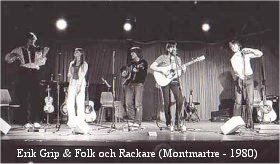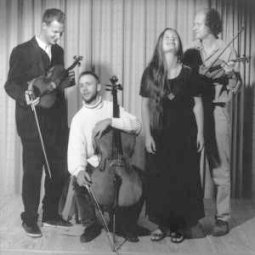| Dan Lundberg: Swedish folk Music - from village greens to concert platforms | |||
|
|
|||
|
New vocal traditions |
|
|
|
|
NEW VOCAL TRADITIONS Since 1970 folk song has come to have an increasingly important position in stage performances of folk music and (as in instrumental music) it is possible to name certain trend-setters in the modern folk song tradition.  Early pioneering contributions were made during the 1970s by the group
Folk och rackare (picture), who arranged songs and ballads to the accompaniment of a
folk instrument ensemble. Folk och rackare can be seen as a kind of
starting point for a tradition which has been confirmed during the 1990s
by Lena Willemark’s interpretations of ballads, for example. A comparison
between Folk och rackare’s LP Stjärnhästen (The Star Horse) from
1981, and Willemark’s and Möller’s CD Nordan (The North Wind, 1994)
shows obvious similarities in tone and moods. The development continues
through the 1990s and traces of Folk och Rackare can be heard in many folk
music groups today. Early pioneering contributions were made during the 1970s by the group
Folk och rackare (picture), who arranged songs and ballads to the accompaniment of a
folk instrument ensemble. Folk och rackare can be seen as a kind of
starting point for a tradition which has been confirmed during the 1990s
by Lena Willemark’s interpretations of ballads, for example. A comparison
between Folk och rackare’s LP Stjärnhästen (The Star Horse) from
1981, and Willemark’s and Möller’s CD Nordan (The North Wind, 1994)
shows obvious similarities in tone and moods. The development continues
through the 1990s and traces of Folk och Rackare can be heard in many folk
music groups today.Folk och rackare 1981: För redeliga män. Från 'Stjärnhästen' (SLPCD2691) Frifot 2003: Balladen om den förtrollade. Från 'Sluring' (AMCD751 Nowadays it is possible to study folk song at the Royal College of Music in Stockholm. The increased interest in folk song has led to new contributions to the Swedish folk music scene, as for example folk music-singing in parts.
De rosor och de blader and En sjöman promenerade. Rotvälta 'I Österled' (UTCD9501)
Davids Nimm. Karin Rehnqvist (PSCD85) Considerable changes have taken place in folk music education during the last decades. Well-qualified teachers who also have a reputation as skilled performers are involved in systematic activities designed to attract young folk musicians and give them practical knowledge of style, technique and repertoire. This role of professional advisor is a new, institutionalised function in Sweden’s folk music world. Through these teachers the repertoire and style of playing of Pers Hans and Eric Sahlström, for example, have been conveyed to many more musicians (and thereby more listeners) than was conceivable in earlier times. |
|
New vocal traditions |
|
|
|
|
|
|||
| Dan Lundberg: Swedish folk Music - from village greens to concert platforms | |||
 The folk music group
Rotvälta (picture), with Susanne Rosenberg, Sven Ahlbäck and
Mikael Marin, has been one of the trend-setters during the 1980s and
1990s, not least in the field of folk song. On the CD I Österled
(In The East) they present music from the Swedish-speaking regions of
Finland. The most interesting tunes are possibly those after Alfred
Lindroos (1859-1938) and Johannes Andersson (1864-1916) from the island of
Stor Pellinge off the south coast of Finland. In Stor Pellinge there was a
tradition of two-part folk singing from the turn of the century, a form
which does not exist in any other Swedish-speaking region.
The folk music group
Rotvälta (picture), with Susanne Rosenberg, Sven Ahlbäck and
Mikael Marin, has been one of the trend-setters during the 1980s and
1990s, not least in the field of folk song. On the CD I Österled
(In The East) they present music from the Swedish-speaking regions of
Finland. The most interesting tunes are possibly those after Alfred
Lindroos (1859-1938) and Johannes Andersson (1864-1916) from the island of
Stor Pellinge off the south coast of Finland. In Stor Pellinge there was a
tradition of two-part folk singing from the turn of the century, a form
which does not exist in any other Swedish-speaking region. The Swedish composer
Karin Rehnqvist’s (picture) use of folk music, and in
particular of special folk song techniques (for example kulning, a
high-pitched form of singing used by women in the grazing pastures in the
mountain regions of Dalarna), in Davids Nimm (1984) and
Puksånger — lockrop (Timpanum Songs — Herding Calls, 1988), can be
seen as a confirmation of the new status of folk song and of a new,
sensitive way of using folk music in art music.
The Swedish composer
Karin Rehnqvist’s (picture) use of folk music, and in
particular of special folk song techniques (for example kulning, a
high-pitched form of singing used by women in the grazing pastures in the
mountain regions of Dalarna), in Davids Nimm (1984) and
Puksånger — lockrop (Timpanum Songs — Herding Calls, 1988), can be
seen as a confirmation of the new status of folk song and of a new,
sensitive way of using folk music in art music.